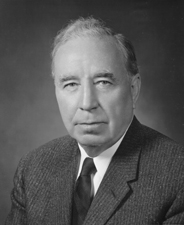Andrew Frank Schoeppel
Andrew Schoeppel | |
|---|---|
 | |
| United States Senator from Kansas | |
| In office January 3, 1949 – January 21, 1962 | |
| Preceded by | Arthur Capper |
| Succeeded by | James B. Pearson |
| 29th Governor of Kansas | |
| In office January 11, 1943 – January 13, 1947 | |
| Lieutenant | Jess C. Denious |
| Preceded by | Payne Ratner |
| Succeeded by | Frank Carlson |
| Personal details | |
| Born | November 23, 1894 Barton County, Kansas, U.S. |
| Died | January 21, 1962 (aged 67) Bethesda, Maryland, U.S. |
| Political party | Republican |
| Spouse(s) | Marie Thomsen |
| Alma mater | University of Kansas University of Nebraska (J.D.) |
| Profession | Attorney, politician |
| Military service | |
| Branch/service | United States Navy |
| Battles/wars | World War I |
| Coaching career | |
| Playing career | |
| 1920–1922 | Nebraska |
| Position(s) | End |
| Coaching career (HC unless noted) | |
| 1929 | Fort Hays State |
| Head coaching record | |
| Overall | 2–5 |
Andrew Frank Schoeppel (November 23, 1894 – January 21, 1962) was an American politician and a member of the Republican Party. He was the 29th Governor of Kansas from 1943 to 1947 and a U.S. Senator from 1949 until his death. He was born in 1894 in Claflin, Kansas, and died in 1962 of abdominal cancer at the National Naval Medical Center at Bethesda, Maryland.[1]
Early life and political career[]
Schoeppel was born near Claflin, Kansas, to immigrant parents from Bohemia.[2] He attended public school and the University of Kansas, but left college to join the Naval Air Service during World War I. After returning home, he graduated from the University of Nebraska Law School in 1922 and was admitted to the Kansas bar the next year.[1]
His early political life began as county attorney in Ness County, Kansas, and was one of the early local officials for Ness City.[3] Later he was elected mayor of Ness City and also served as chairman of the Kansas Corporation Commission.[4]
In 1952 Schoeppel supported Senator Robert A. Taft for president over fellow Kansan Dwight D. Eisenhower.[citation needed]
Schoeppel voted in favor of the Civil Rights Act of 1957,[5] but did not vote on the Civil Rights Act of 1960.[6]
College football[]
Schoeppel played college football from 1920 to 1922 while attending the University of Nebraska and made "honorable mention" on one of Walter Camp's first All-America football teams.[7] He served as the head football coach at Fort Hays State University for one season, in 1929, compiling a record of 2–5. Schoeppel filled in as head coach while his predecessor, William D. Weidein, was on sabbatical. Weidein did not return after his one-year sabbatical. After Schoeppel completed his one year as head coach, the school's program was taken over by W. C. "Jack" Riley.[8]
Head coaching record[]
| Year | Team | Overall | Conference | Standing | Bowl/playoffs | ||||
|---|---|---|---|---|---|---|---|---|---|
| Fort Hays State Tigers (Central Intercollegiate Conference) (1929) | |||||||||
| 1929 | Fort Hays State | 2–5 | 2–4 | T–5th | |||||
| Fort Hays State: | 2–5 | 2–4 | |||||||
| Total: | 2–5 | ||||||||
See also[]
References[]
- ^ Jump up to: a b Biographical Directory of the United States Congress
- ^ "United States Census, 1900", FamilySearch, retrieved March 20, 2018
- ^ Kansas Heritage-Ness County Archived May 16, 2008, at the Wayback Machine
- ^ Kansas Governor's Records - Andrew F. Schoeppel Administration - Jan. 11, 1943 - Jan. 12, 1947 - Kansas State Historical Society
- ^ "HR. 6127. CIVIL RIGHTS ACT OF 1957". GovTrack.us.
- ^ "HR. 8601. PASSAGE OF AMENDED BILL".
- ^ Office of the Governor of Kansas Archived 2007-09-28 at the Wayback Machine
- ^ Fort Hays Coaching Records Archived 2011-05-25 at the Wayback Machine
External links[]
- Publications concerning Kansas Governor Schoeppel's administration available via the KGI Online Library
- Andrew Frank Schoeppel at Find a Grave
| show |
|---|
- 1894 births
- 1962 deaths
- Governors of Kansas
- Mayors of places in Kansas
- United States senators from Kansas
- Republican Party United States senators
- Kansas Republicans
- Fort Hays State Tigers football coaches
- Nebraska Cornhuskers football players
- University of Kansas alumni
- United States Navy personnel of World War I
- People from Barton County, Kansas
- People from Ness City, Kansas
- Deaths from cancer in Maryland
- Deaths from stomach cancer
- American Methodists
- Kansas lawyers
- Republican Party state governors of the United States
- 20th-century American politicians
- Players of American football from Kansas
- American people of Bohemian descent
- United States Naval Aviators

